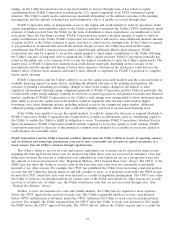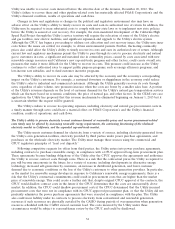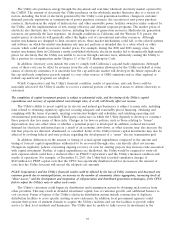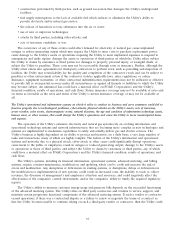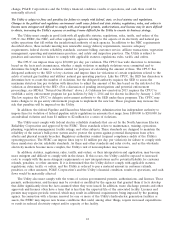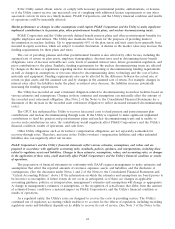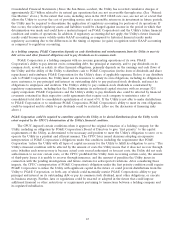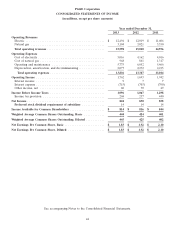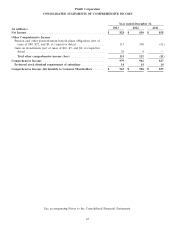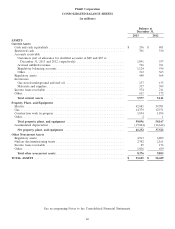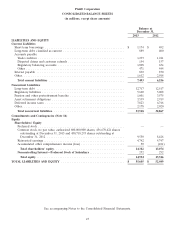PG&E 2013 Annual Report Download - page 48
Download and view the complete annual report
Please find page 48 of the 2013 PG&E annual report below. You can navigate through the pages in the report by either clicking on the pages listed below, or by using the keyword search tool below to find specific information within the annual report.If the Utility cannot obtain, renew, or comply with necessary governmental permits, authorizations, or licenses,
or if the Utility cannot recover any increased costs of complying with additional license requirements or any other
associated costs in its rates in a timely manner, PG&E Corporation’s and the Utility’s financial condition and results
of operations could be materially affected.
Market performance or changes in other assumptions could require PG&E Corporation and the Utility to make significant
unplanned contributions to its pension plan, other postretirement benefits plans, and nuclear decommissioning trusts.
PG&E Corporation and the Utility provide defined benefit pension plans and other postretirement benefits for
eligible employees and retirees. The Utility also maintains three trusts for the purposes of providing funds to
decommission its nuclear facilities. Up to approximately 60% of the plan assets and trust assets have generally been
invested in equity securities, which are subject to market fluctuation. A decline in the market value may increase the
funding requirements for these plans and trusts.
The cost of providing pension and other postretirement benefits is also affected by other factors, including the
assumed rate of return on plan assets, employee demographics, discount rates used in determining future benefit
obligations, rates of increase in health care costs, levels of assumed interest rates, future government regulation, and
prior contributions to the plans. Similarly, funding requirements for the nuclear decommissioning trusts are affected
by changes in the laws or regulations regarding nuclear decommissioning or decommissioning funding requirements
as well as changes in assumptions or forecasts related to decommissioning dates, technology and the cost of labor,
materials and equipment. Funding requirements also can be affected by the difference between the actual rate of
return on plan assets and the assumed rate and by changes in the assumed rate of return. For example, changes in
interest rates affect the liabilities under the plans: as interest rates decrease, the liabilities increase, potentially
increasing the funding requirements.
The Utility has recorded an asset retirement obligation related to decommissioning its nuclear facilities based on
various estimates and assumptions. Changes in these estimates and assumptions can materially affect the amount of
the recorded asset retirement obligation. (See Note 2 of the Notes to the Consolidated Financial Statements for a
discussion of the increase in the recorded asset retirement obligation to reflect increased estimated decommissioning
costs.)
The CPUC has authorized the Utility to recover forecasted costs to fund pension and postretirement plan
contributions and nuclear decommissioning through rates. If the Utility is required to make significant unplanned
contributions to fund the pension and postretirement plans and nuclear decommissioning trusts and is unable to
recover such contributions in rates, the contributions would negatively affect PG&E Corporation’s and the Utility’s
financial condition, results of operations, and cash flows.
Other Utility obligations, such as its workers’ compensation obligations, are not separately earmarked for
recovery through rates. Therefore, increases in the Utility’s workers’ compensation liabilities and other unfunded
liabilities also can negatively affect net income.
PG&E Corporation’s and the Utility’s financial statements reflect various estimates, assumptions, and values and are
prepared in accordance with applicable accounting rules, standards, policies, guidance, and interpretations, including those
related to regulatory assets and liabilities. Changes to these estimates, assumptions, values, and accounting rules, or changes
in the application of these rules, could materially affect PG&E Corporation’s and the Utility’s financial condition or results
of operations.
The preparation of financial statements in conformity with GAAP requires management to make estimates and
assumptions that affect the reported amounts of revenues, expenses, assets, and liabilities, and the disclosure of
contingencies. (See the discussion under Notes 1 and 2 of the Notes to the Consolidated Financial Statements and
‘‘Critical Accounting Policies’’ above.) If the information on which the estimates and assumptions are based proves to
be incorrect or incomplete, if future events do not occur as anticipated, or if there are changes in applicable
accounting guidance, policies, or interpretation, management’s estimates and assumptions will change as appropriate.
A change in management’s estimates or assumptions, or the recognition of actual losses that differ from the amount
of estimated losses, could have a material impact on PG&E Corporation’s and the Utility’s financial condition or
results of operations.
As a regulated entity, the Utility’s rates are designed to recover the costs of providing service. The Utility’s
continued use of regulatory accounting (which enables it to account for the effects of regulation, including recording
regulatory assets and liabilities) depends on its ability to recover its cost of service. (See Note 3 of the Notes to the
42



